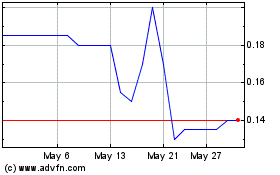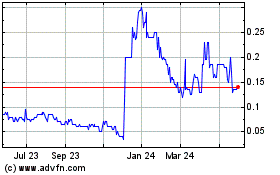Ximen Mining Corp. (TSX-V:XIM) (OTCQX:XXMMF) (the "Company" or
"Ximen") is pleased to announce results from the recently completed
ground magnetic and VLF-EM survey on its Brett property located
near Vernon, BC. (the first ever on the Brett property).
The survey outlined a very large, very strong mag-low anomaly in
an area of the property that has little previous exploration. The
newly discovered mag-low anomaly measures 1.1 x 1.1 km in size and
remains open to the north and east. It is a blind target under
glacial till cover, with minimal rock exposed on
surface. Elsewhere on the property, at the Main Zone and also
to the west of the Main Zone, similar (but much smaller) magnetic
low anomalies were defined by the ground geophysical survey in
areas with known gold-bearing epithermal veins and associated
magnetite-destructive alteration.
"We are pleased with the results that are becoming available
from our spring and summer work program on the 100% owned Brett
Gold Property." said Christopher Anderson, president and
chief executive officer of Ximen Mining. "Our technical
team has done an excellent job of analysing and compiling all of
the historical data which has allowed them to build a comprehensive
knowledge base on the property. The property hosts several
different styles of Gold mineralization and several new epithermal
veins have been discovered todate. With the current drill permit
that is in place we will continue to focusing on developing drill
targets for the upcoming drill program that will advance the high
grade potential of the property."
The large mag-low anomaly encompasses the Gossan Zone, where
intense, impressive epithermal alteration occurs over a 350 x 50 m
area on the steep side of a deeply incised gully. Just beyond
the survey limits, where the mag-low anomaly remains open to
extension to the north, is a historic exploration trench. The Milo
Trench exposes strongly silicified, pyritic rocks and quartz
stockwork veining, on-strike to the north from the Gossan
Zone. It extends the strike length of the alteration system in
this part of the property to 950 m. Assays from the Milo Trench are
pending.
The spatial relationship of the mag-low feature to the Gossan
Zone and the Milo Trench suggests that the mag-low is related to
the same magnetite-destructive alteration exposed in these
areas. The size and strength of the anomaly suggests a very
large alteration zone, extending laterally well beyond the
exposures seen at the Gossan Zone and Milo trench.
The southwestern edge of the big mag-low anomaly is located 500
m northwest of the Main Zone. Anomalous arsenic at depth in drill
holes west of the Main Zone is a geochemical vector towards the
mag-low (i.e. the elevated arsenic is a distal part of the
mineralizing system, whose core is in the big mag low). Other
support for the idea that the mag-low anomaly is related to
alteration comes from magnetic susceptibility readings on historic
drill core, which demonstrate that epithermal alteration on the
property has a low magnetic response. Lobe-like mag-low
features trailing off from the edges of the anomaly are also
suggestive of an alteration origin for the anomaly, with the
alteration extending outwards along structures from the
core/central area.
An alteration-origin to the mag-low anomaly is exciting, because
it suggests a very large mineralizing system. Given the age of
the host rocks and the proximity to known epithermal gold
mineralization elsewhere on the property, the most likely
mineralization model is an epithermal system, with a very extensive
alteration zone. The anomaly appears too big and too strong to
simply be the result of alteration associated with a simple
epithermal vein, like at the Main Zone. One possible
explanation, consistent with the size of the anomaly, is a
low-grade, bulk tonnage epithermal system. The type-example
for this deposit style is New Gold's Blackwater deposit in central
BC. That deposit is an epithermal deposit hosted within
similar volcanic and volcaniclastic rocks to those on the Brett
property. The Blackwater deposit has a NI 43-101 compliant
Measured + Indicated mineral resource, effective December 31, 2013,
of 396,903 million tonnes grading 0.74 g/t Au and 5.5 g/t Ag, or a
total contained metal content of 9.5 million ounces gold and 70.1
million ounces silver, at a cut-off grade of 0.4 g/t AuEq. The
Blackwater deposit measures 1.2 km x 700 m in size and has a depth
extent of 400 m. The newly discovered mag-low anomaly on the
Brett property is large enough to host a deposit of these
dimensions. It currently measures 1.1 x 1.1 km in size, and
is open to the north and east.
An alternate explanation to the origin of the mag-low anomaly is
that it results from a large body of non-magnetic rock, not exposed
on surface. In this scenario, the target is a 950 m long x 50
m (minimum) wide zone of intense epithermal alteration, the best
exposed on the property, that deserves testing at depth for
high-grade vein targets. Alternately, the target is a more
laterally extensive zone of alteration related to bulk-tonnage gold
mineralization.
In preparation for drilling the anomaly, the Company is
initiating several different testing methods. In areas with road
access, auger soil sampling will be done, to attempt to penetrate
the glacial till cover and obtain soil samples from near the
bedrock surface. An IP survey is planned to provide subsurface
definition of the anomaly area. The IP survey will identify
areas of resistivity (silicification) and areas of chargeability
(disseminated sulfide mineralization). A biogeochemical
survey is also planned over the mag-low anomaly. This survey (bark,
twigs, organic matter) will be another attempt at seeing through
the glacial till cover and establishing geochemical trends in the
area. Finally, we are undertaking a spectral study of clay minerals
in alteration from various parts of the property, which will help
us understand the epithermal system better and may provide heat
vectors to the core of the system.
The Brett property continues to show excellent potential for
high-grade epithermal gold veins, similar to those that were
targeted by historic exploration on the property. The company
is continuing to explore for these veins, which could potential be
exploited by underground methods. The upcoming drill program
will test vein targets at the Main Zone, Gossan Zone, and elsewhere
on the property. A previously reported intercept of 4.9 oz/t
Au over 1.3 m in hole 04-12 is a high priority target for
drilling. This hole represents the only drill hole that has
tested this zone, located at depth, east of the Main Zone.
To recap some of the history of this part of the Brett property,
coarse placer gold was discovered in creeks draining the property
in 1983. In 1984, follow-up prospecting located impressive
epithermal alteration at the Gossan Zone. Very shortly
thereafter, visible gold was located in quartz veins exposed in
outcrop 1 km to the southwest, at what is now the Main Shear- RW
Zone (the Main Zone). From 1985 to 2004, essentially all of
the work on the property was focussed on the Main Shear, which we
now recognize as a late structure that cuts and dismembers an
earlier epithermal vein system. During that period of
exploration, there was no recognition of, or at very least no
scientific approach to locating, the primary source to the
epithermal mineralization. No work was done over the 10 year
period from 2004 to 2014, when Ximen began the current work
program. From discovery to present, only 4 short drill
diamond drill holes have been drilled at the Gossan Zone, and none
tests the strongest portion of the recently discovered mag-low
anomaly.
Patrick Forseille, P. Geo., a Qualified Person as defined by NI
43-101 is responsible for the technical information contained in
this release.
The Company further announces that it has granted options to
purchase 1,000,000 shares to certain officers, consultants and
directors of the Company. The options shall be exercisable at a
price of $00.70 cents per share and shall have a term of two
years.
About Ximen Mining Corp.
Ximen Mining Corp. owns 100 percent interest in its two
projects, Gold Drop Project and Brett Gold Project located in
southern British Columbia. Ximen is a publicly listed company
trading on the TSX Venture Exchange under the symbol XIM, and is
listed on the Frankfurt, Munich, and Berlin Stock Exchanges in
Germany under the symbol 1XM and WKN number is A1W2EG as well in
the USA on the OTCQX under the symbol XXMMF.
On behalf of the Board of Directors, "Christopher R. Anderson."
Christopher R. Anderson, President, CEO and Director, Ximen Mining
Corp.
For further information, please contact Ward
Kondas 604-488-3900 or by email at
ward@ximenminingcorp.com.
This press release includes certain statements that may be
deemed "forward-looking statements". All statements in this
release, other than statements of historical facts, that address
future exploration drilling, exploration activities and events or
developments that the Company expects, are forward looking
statements. Although the Company believes the expectations
expressed in such forward-looking statements are based on
reasonable assumptions, such statements are not guarantees of
future performance and actual results or developments may differ
materially from those in forward-looking statements. Factors that
could cause actual results to differ materially from those in
forward-looking statements include exploitation and exploration
successes, continued availability of financing, and general
economic, market or business conditions.
Neither TSX Venture Exchange nor its Regulation Services
Provider (as that term is defined in the policies of the TSX
Venture Exchange) accepts responsibility for the adequacy or
accuracy of this release.
Ximen Mining (TSXV:XIM)
Historical Stock Chart
From Dec 2024 to Jan 2025

Ximen Mining (TSXV:XIM)
Historical Stock Chart
From Jan 2024 to Jan 2025
